7 Best Single Leg Squat Variations (with Pictures!)
Whether you’re a calisthenics athlete or a weightlifter looking to supplement the back squat, the single leg squat presents one highly viable option.
However, the single leg squat itself is not the only exercise of its kind. Quite a number of different exercises technically fall under the description of a single leg squat - some of which you’re likely already performing.
Apart from the conventional single leg squat, the pistol squat, shrimp squat and Hawaiian squat are all traditionally bodyweight unilateral squat variations.
Alternatively, movements like the Bulgarian split squat and even lunges can technically be considered single leg squat variants.
What are Single Leg Squats?
To put it concisely, a single leg squat is simply a unilateral lower body exercise involving marked use of hip and knee flexion.
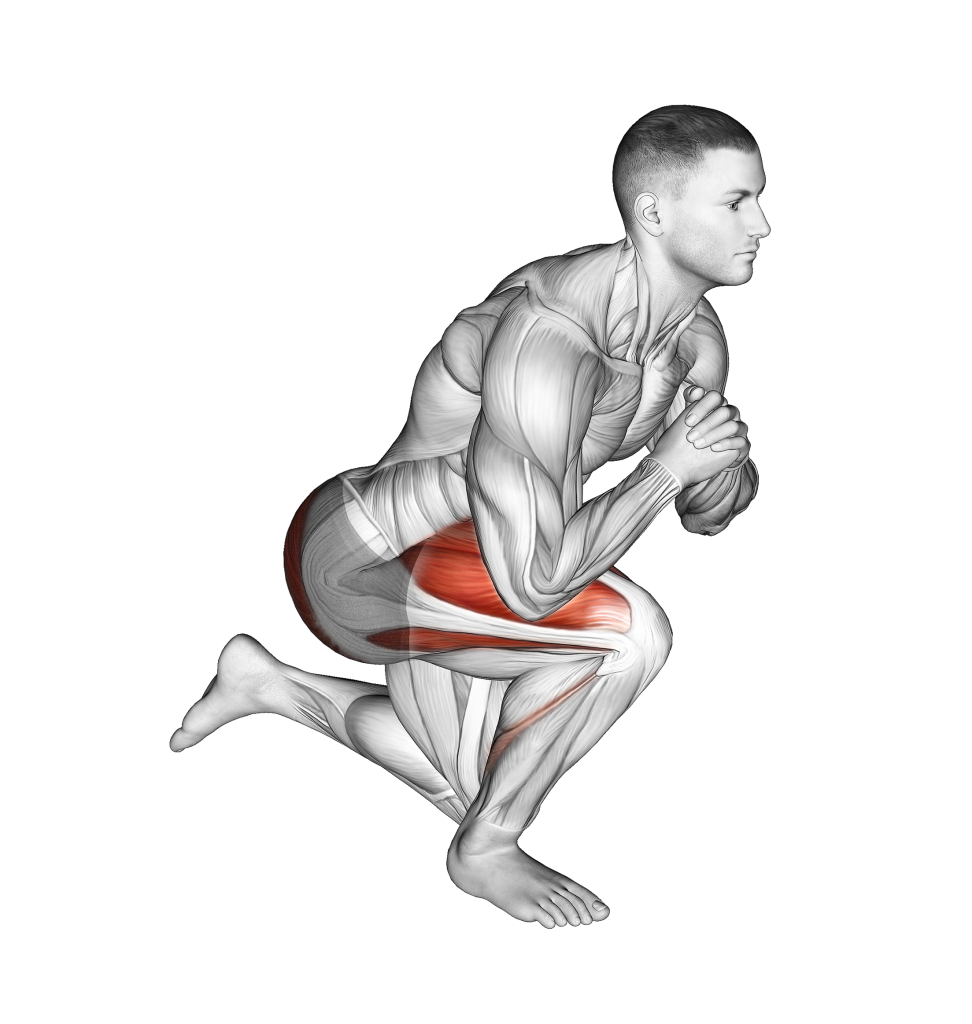
These types of exercises are often performed with bodyweight resistance alone, but can also be weighted in the training of more advanced athletes.
Single leg squats are most frequently included into training programs so as to emphasize the quadriceps and glutes - building not only strength and muscle mass, but also bodily coordination, balance and to correct any muscular imbalances.
Most single leg squat variations simply alter how the body’s weight is distributed through the single standing leg. This can alter which muscle group is emphasized, to what extent such muscles are recruited and the difficulty in which the body can be balanced.
However, outside of non-representative single leg squat exercises (like the lunge or split squat), all single leg squat variations involve only one foot remaining on the floor throughout the set.
Single Leg Squat Variations
1. The Conventional Single Leg Squat
The conventional single leg squat is simply a squat performed with one leg extended slightly above the floor, allowing for greater emphasis on one leg without a significant loss of balance.
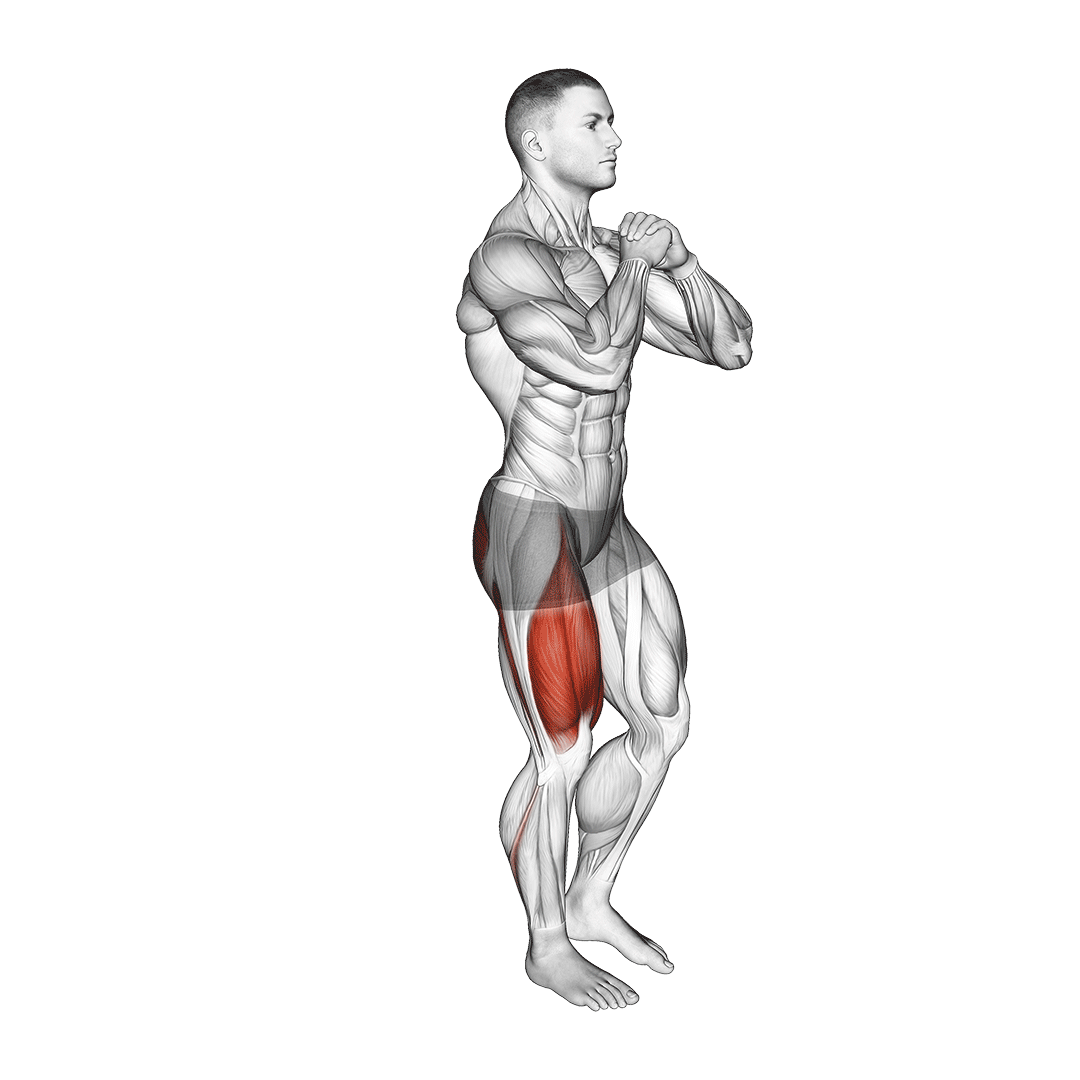
Like most other single leg squat variations, the conventional kind is considered a compound movement primarily meant to be done with bodyweight resistance alone.
Due to its unilateral nature, the conventional single leg squat is considerably more difficult than most bilateral squat variations.
Muscles Worked
Conventional single leg squats primarily target the quadriceps femoris, but will also work the glutes and hamstrings depending on the depth of the squat.
In addition, the core and calves are both worked harder than with bilateral squats due to the greater inherent balance demands of being on one leg.
Defining Benefits as a Single Leg Squat Variation
The main benefit to single leg squats is its considerable challenge in more than just gross muscular strength. Bodily coordination, muscular endurance and sense of balance are all trained with regular performance of single leg squats, regardless of variation.
Furthermore, the single leg squat is one method of achieving progression for exercisers that do not have access to weighted equipment.
Simply master two-legged squat variations, then switch to single leg squats once the former is no longer useful for progression.
How-to:
To perform a repetition of the single leg squat, the exerciser will first begin by standing on two legs with their feet around hip-width apart. For balance, the arms may be extended out to the sides or forwards.
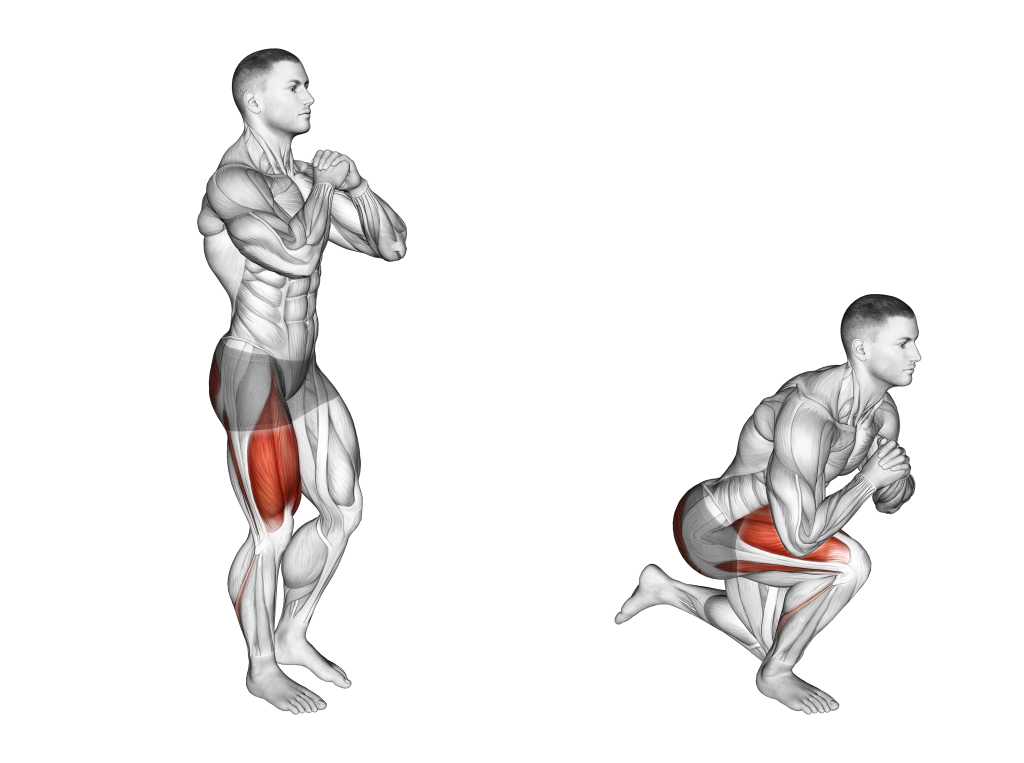
Lifting one foot off the ground, the exerciser then braces their core and faces their head forwards so as to protect the spine.
Once this is achieved, they will then push their hips slightly back and bend their remaining knee, lowering themselves to parallel depth or until balance becomes difficult.
To complete the repetition, the exerciser then drives through their heel and extends their knee - rising up to a standing stance once more. Don’t forget to also repeat the exercise with the opposite leg.
2. The Assisted Single Leg Squat
For exercisers that wish to perform a single leg squat but have difficulty maintaining their balance, it is entirely possible to perform the exercise assisted.

This can be done either by performing the exercise while gripping a stationary object, or otherwise holding a pole and pressing it into the floor throughout each set.
Apart from greatly reduced balance demands, the assisted variation of single leg squat remains much the same as its conventional counterpart. The pole-assisted variation is preferable as less of the body’s weight will be transferred away from the working leg, keeping most of the exercise’s intensity.
Muscles Worked
The assisted single leg squat targets the same muscles as a regular one - meaning the quadriceps femoris, glutes and hamstrings.
However, because of the reduced need for balance, the core and calves will be worked to a comparatively lesser degree.
Defining Benefits as a Single Leg Squat Variation
With a reduced need for balance comes a reduced risk of injury and greater accessibility to novice exercisers. Those who do not have the confidence or lower body strength to perform conventional single leg squats can begin with the assisted variant as an initial entry into one-leg exercises.
How-to:
Performing an assisted single leg squat is exactly the same as an unassisted one. Stand with the feet wider than hip-width apart, either facing a stationary object or gripping a pole on the non-working side of the body.
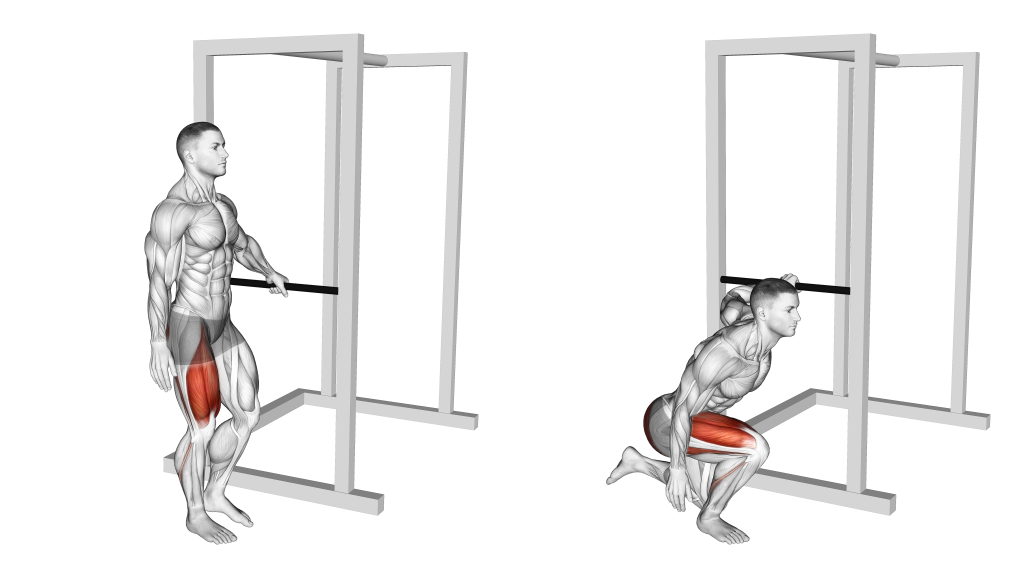
Use the hands to either press the pole into the ground or to lean slightly on the stationary object for balance.
Then, the exerciser raises one leg off the floor and proceeds to bend their one remaining knee, pushing the hips back as they do so.
They will lower themselves until the top of the hip is parallel with the top of the knee before driving through their heel and rising back to a standing position. This completes the rep.
3. The Pistol Squat
The pistol squat is a popular variation of single leg squat where one leg is raised parallel to the floor, rather than simply off the ground. This greatly increases the difficulty of the exercise from both a balance and muscular exertion standpoint.
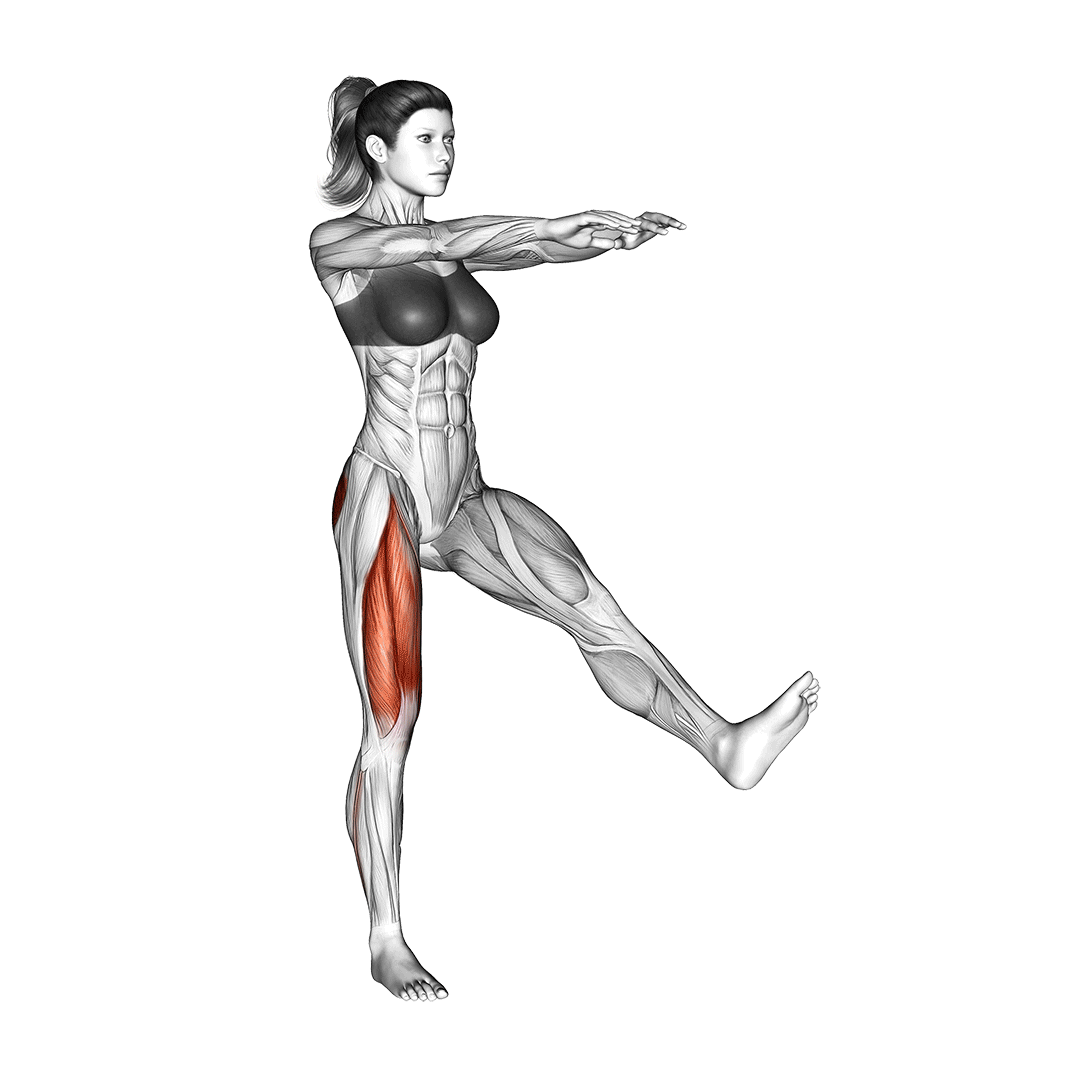
Pistol squats are primarily used as an advanced calisthenics exercise once single leg squats are no longer challenging.
Otherwise, much the same mechanics as regular single leg squats are used - knee and hip flexion to approximate parallel depth.
Muscles Worked
Pistol squats work the quadriceps, glutes and hamstrings to a greater degree than most other squat variations.
In addition, the hip flexors and lower back muscles are targeted to a far greater degree as well. Of course, this is alongside the calves and other core muscles.
Defining Benefits as a Single Leg Squat Variation
As mentioned, pistol squats are a more challenging form of single leg squat. In nearly every aspect, the pistol squat is comparatively more intense - be it balance, muscular recruitment, coordination or technique expertise.
With greater intensity comes the capacity for further progression and greater muscular development.
So long as they are performed correctly, pistol squats can improve a wide variety of physical capabilities in advanced-level athletes.
How-to:
To perform a pistol squat, the exerciser first begins with their feet around hip-width apart, aligning the toes either forwards or slightly outwards.
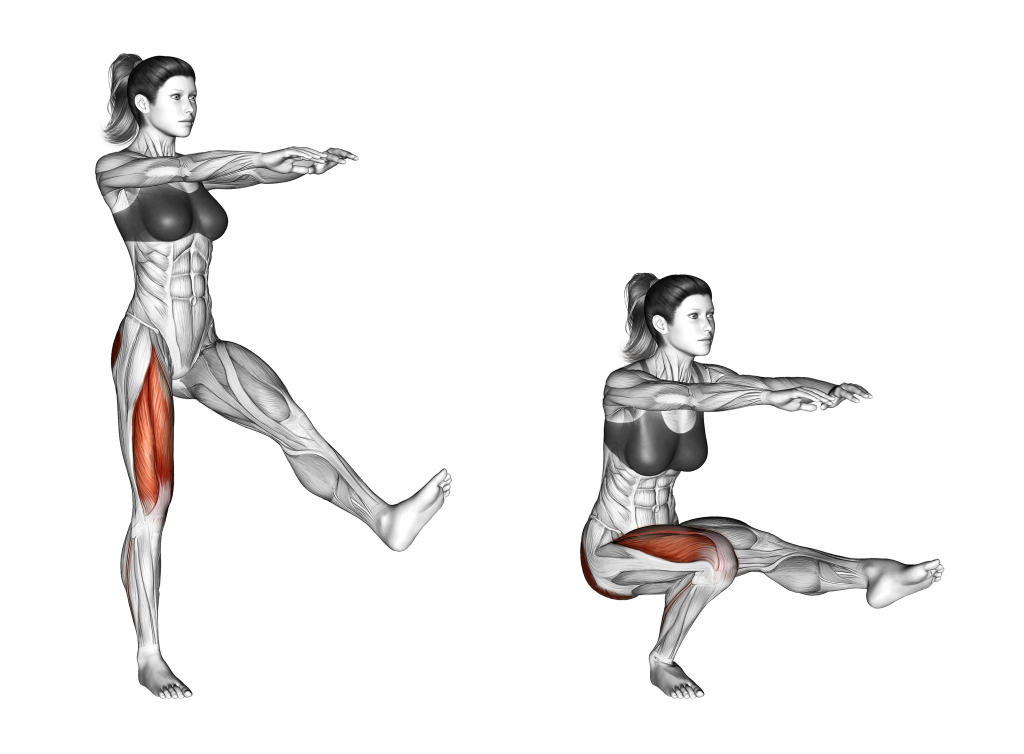
Then, extending one leg until it is parallel off the floor, the exerciser will bend at the knee and lower their hips downwards.
The raised leg should remain fully extended forwards throughout the rep. The core should also be braced, with the exerciser taking care to keep the torso as vertical as possible.
Once reaching parallel squatting depth or lower, the exerciser then drives through their heel and rises back to an upright position. Repeat with the opposite leg.
The pistol squat can be made somewhat easier by bending the upper torso forwards and gripping the extended leg. This aids with balance, but can also place the lower back at risk of injury. Ensure the spine is neutral if attempting this variant of pistol squat.
4. The Shrimp Squat
The shrimp squat is a form of single leg squat most comparable to the pistol squat, only with a somewhat lesser level of intensity and an easier time maintaining balance.
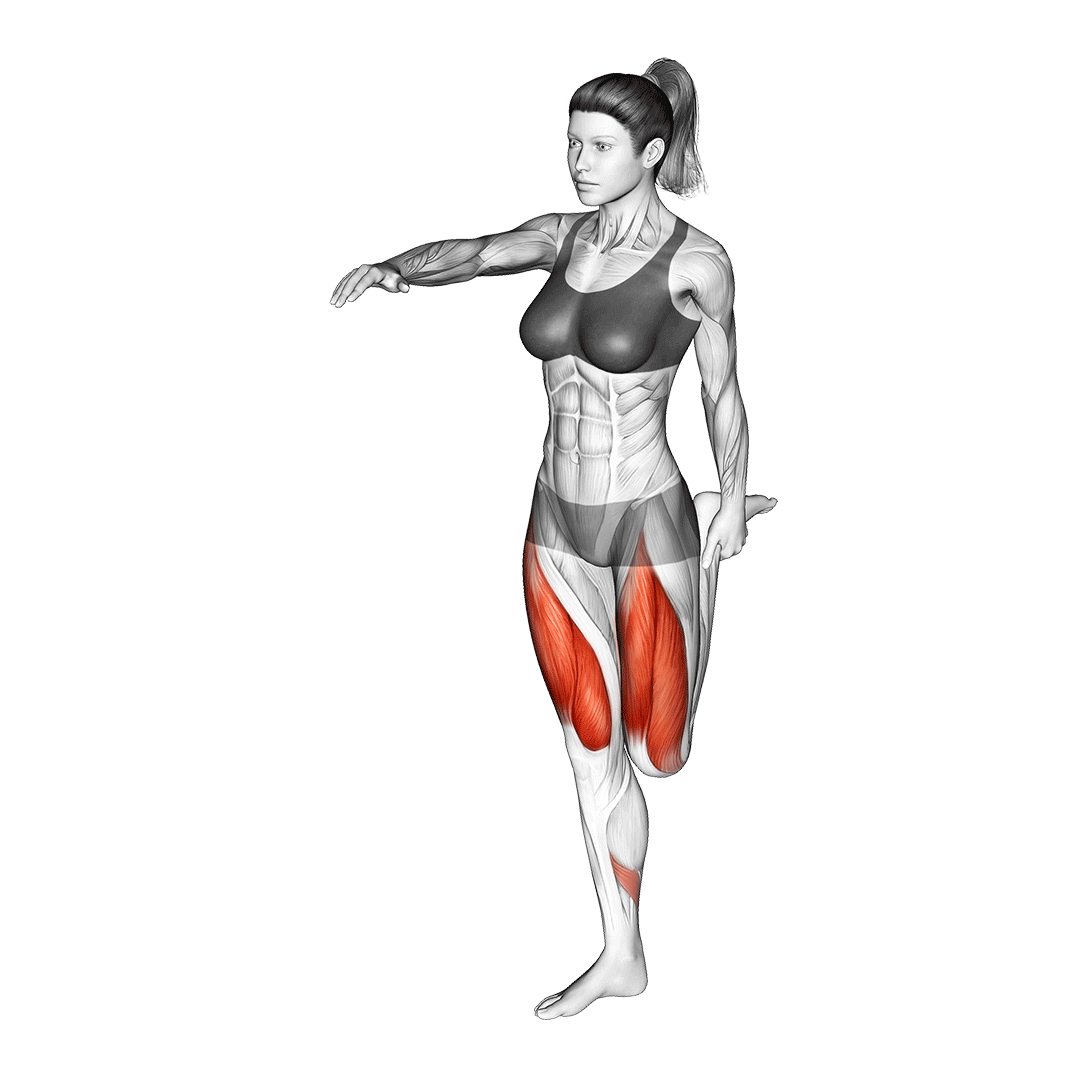
The defining characteristic of shrimp squats lies in the position of the raised leg - of which is bent behind the body at the knee. This leg is also gripped behind the body with one arm, further aiding with stability.
Alongside this change in leg angle, the shrimp squat also allows for a somewhat more forward orientation to the torso, aiding in distribution of weight into the sole remaining leg and allowing for greater recruitment of certain muscle groups.
Muscles Worked
Shrimp squats target the quadriceps femoris and hip flexors to a greater degree than regular single leg squats. In addition, the glutes, hamstrings and core are also targeted.
Defining Benefits as a Single Leg Squat Variation
The main benefit to shrimp squats is its capacity to act as a progression step to more complex single leg squat variations. Exercisers with difficulty performing pistol squats but find regular single leg squats too easy can practice with the shrimp squat.
Furthermore, shrimp squats can also be used as a method of maximizing quadriceps and hip flexor volume without the same stability and balance demands.
How-to:
To perform a shrimp squat, the exerciser will begin with their feet slightly wider than hip-width apart, toes pointing forwards or slightly outwards. One arm should be extended forwards for greater balance.
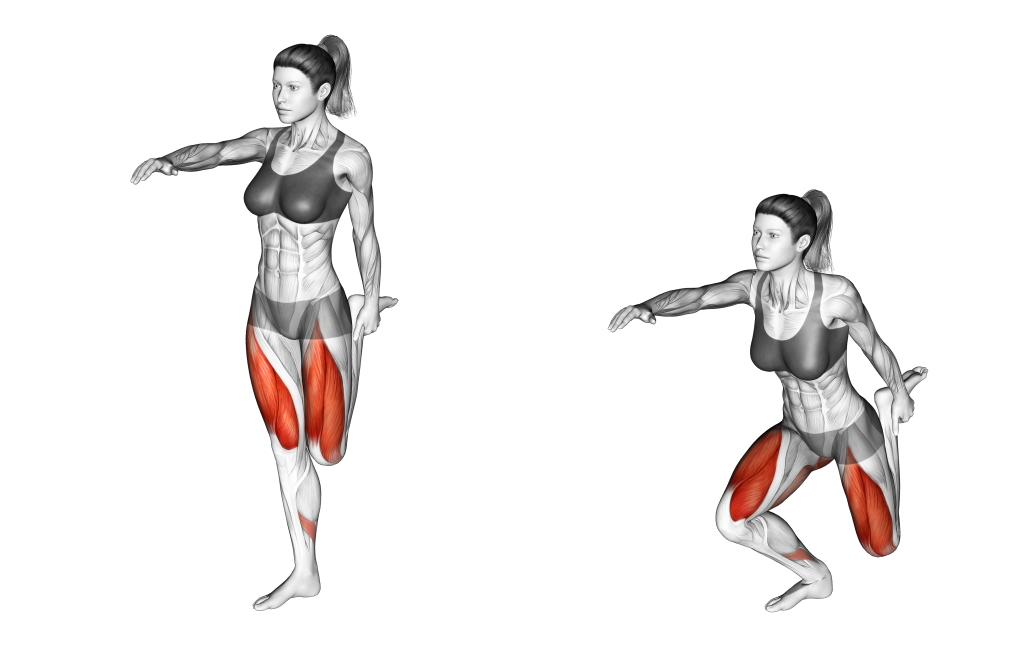
From this position, the exerciser raises one foot behind their body at the knee, gripping the ankle or foot with the hand of the same side. If done correctly, the knee will be pointing immediately downwards towards the floor.
This may necessitate bending of the waist. Rather than bending towards the side, it is best for the torso to bend forwards over the hips so as to help with balance.
Once in the correct stance, the exerciser then bends at the knee and pushes their hips back, lowering until the bent knee is almost touching the ground.
To complete the repetition, drive through the one remaining heel and rise back to a standing position, straightening the torso.
5. The Bulgarian Split Squat
Bulgarian split squats are a form of single leg squat where one foot is raised behind the body atop a platform. This greatly reduces the difficulty one will encounter when trying to balance the movement.
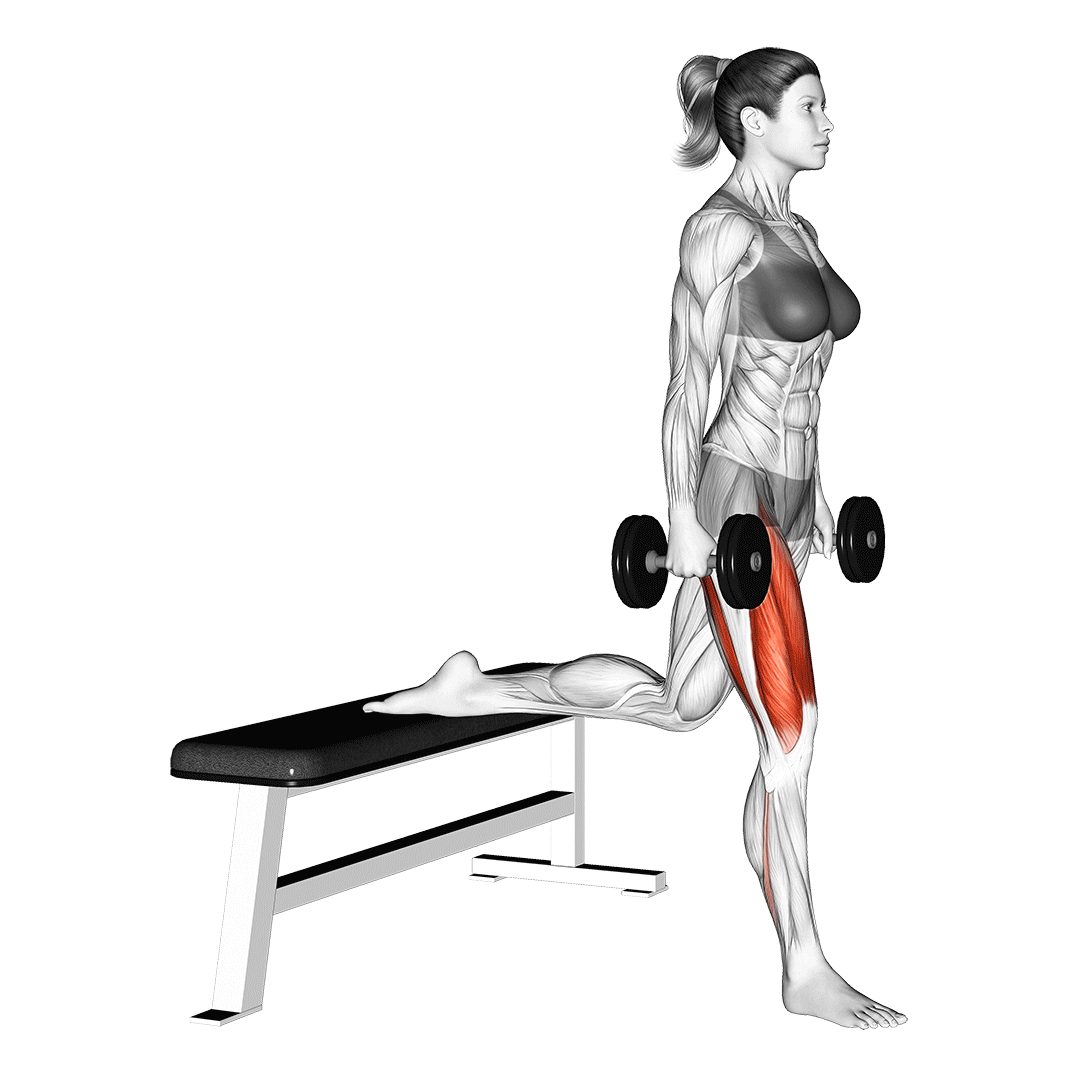
In comparison to other split squat or single leg squat variations, the Bulgarian kind allows for a deeper squat depth to be achieved and a more forward distribution of the body’s weight.
While this does indeed come with a slightly greater risk of knee strain, the lack of falling as an injury factor helps balance the total injury risk out.
Muscles Worked
Because the knee tracks somewhat more forward and more of the body’s weight is shifted towards the anterior side, the Bulgarian split squat emphasizes the quadriceps femoris and hip flexors more than it does the glutes and hamstrings.
In addition, the calves and core are not worked as hard as with other single leg squat variations due to the support of the bench behind the exerciser.
Defining Benefits as a Single Leg Squat Variation
Apart from being easier to balance, the Bulgarian split squat is also quite effective as a novice-friendly exercise, as it requires considerably less technique familiarity than other forms of single leg squat.
In addition, unlike pistol squats or shrimp squats where loading with additional weight may be difficult, Bulgarian split squats are regularly performed with the addition of dumbbells or kettlebells. These items may be held either in a goblet grip or at the sides in both hands.
How-to:
To perform a repetition of the Bulgarian split squat, the exerciser will stand facing away from an exercise bench or similar platform.
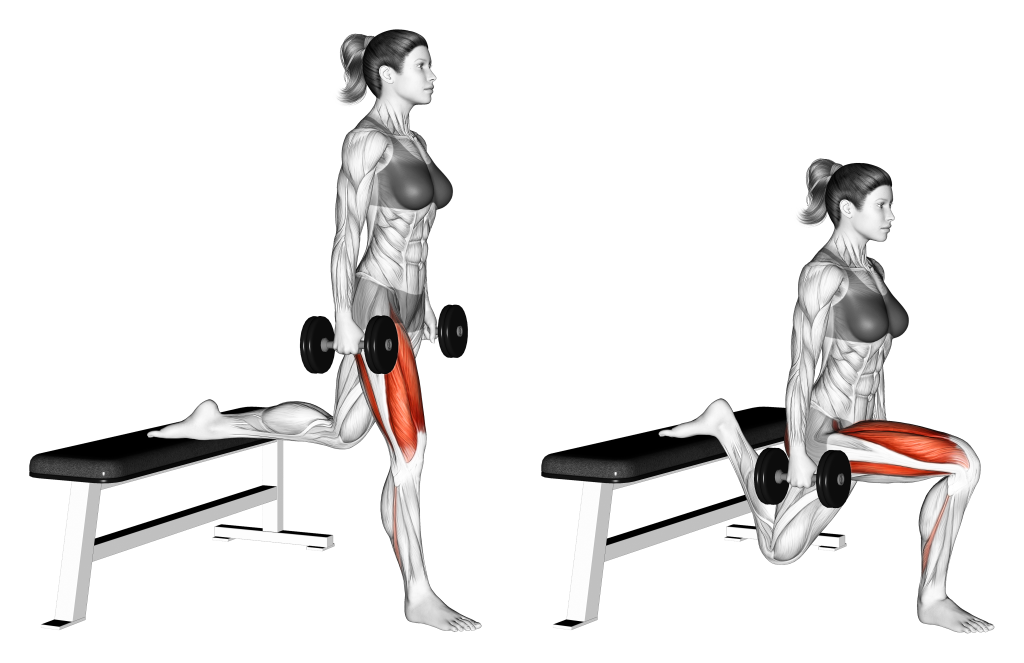
Raising one foot and placing it soles-up atop the bench, the exerciser then tilts their hips slightly forwards and shifts their weight towards their still-standing leg.
From this stance, the exerciser will bend both knees simultaneously, keeping the torso vertical as they lower themselves downwards.
Once the back knee is at a 90 degree angle of flexion, they will then drive through their heel and rise back to an upright position - thereby completing the repetition.
6. The Hawaiian Squat
Like shrimp squats, Hawaiian squats are considered a single leg squat variation that is comparatively easier than the pistol squat.
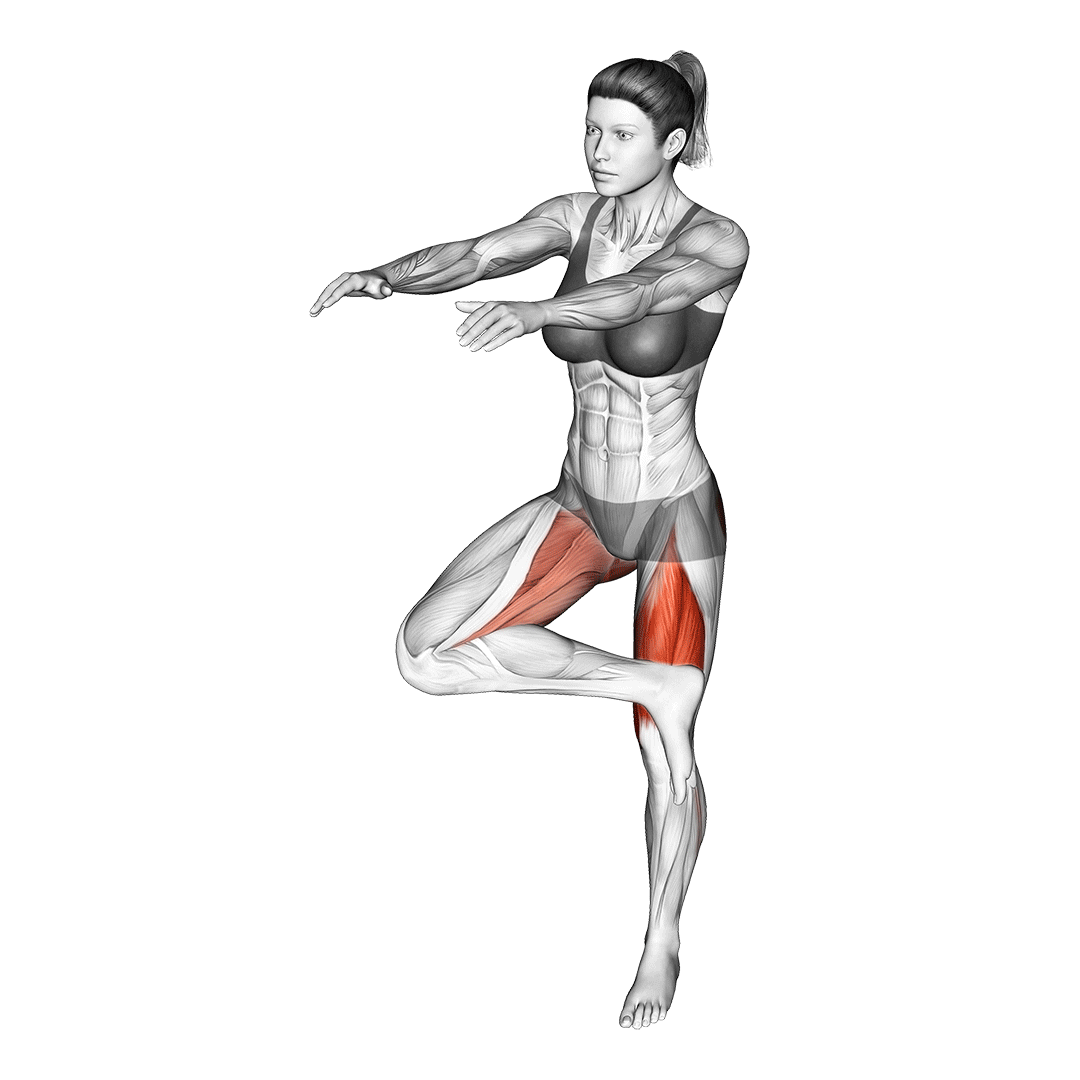
Rather than raising one leg straight out or gripping it behind the body, the Hawaiian squat instead has the exerciser bend their knee inwards and set their shin atop the thigh of the working leg, as if sitting cross-legged.
While this is indeed more demanding in terms of knee and hip mobility, it is considered to be easier to balance for some - and allows both arms to be extended for greater mobility or for loading with weights.
Muscles Worked
The Hawaiian squat targets the quadriceps femoris the most - but will also work the hamstrings of both legs, as well as the glutes.
The hamstrings being targeted on both sides is a result of the raised leg being bent inwards. While the standing leg’s hamstring muscles will clearly be worked to a greater intensity, those on the opposite side will be targeted to a lesser level as well.
Mobilizer muscles aside, like most other single leg squats, Hawaiian squats also target the core muscles and calves in an isometric capacity.
Defining Benefits as a Single Leg Squat Variation
As touched upon previously, the Hawaiian squat is of note for being easier to stabilize than a pistol squat despite both hands being free to grip weights or aid in balance.
This makes it suitable for both less experienced exercisers and athletes who wish to avoid the more encumbering downsides of the pistol squat.
How-to:
To perform a Hawaiian squat, the exerciser will first begin in the standard squat stance by placing the feet wider than hip-width apart, torso upright and toes pointing forwards or slightly out.
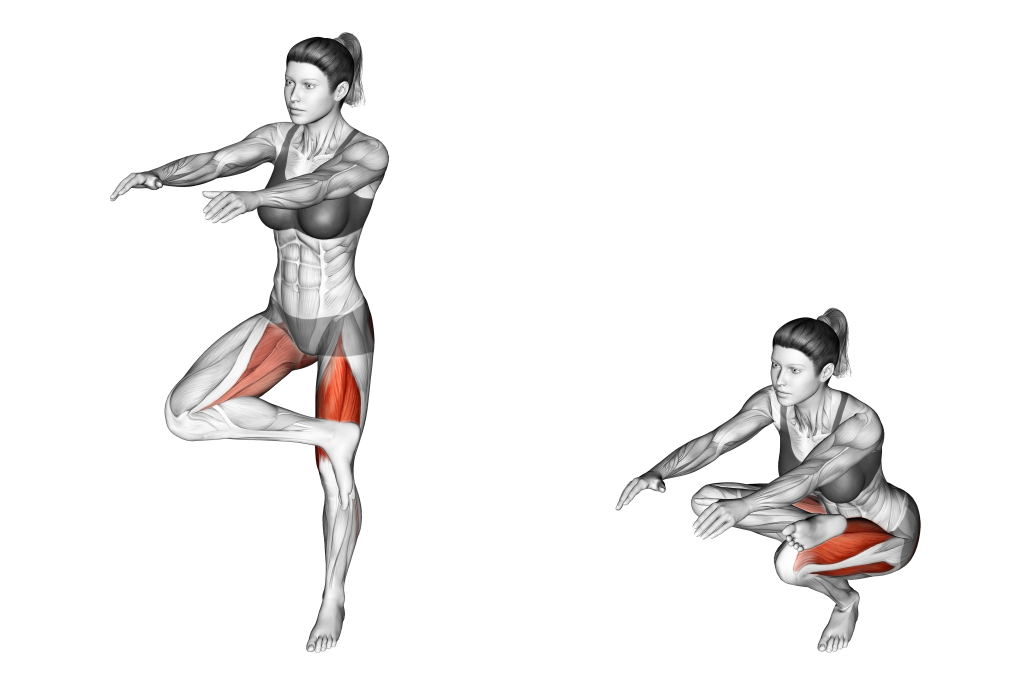
Then, raising one leg and bending at the knee to place the shin along the thigh, the exerciser will extend their arms out for greater balance.
Once the ankle or shin is secured atop the opposite leg, the exerciser pushes their pelvis back and bends at the knees, lowering into a squat.
When they’ve reached the appropriate depth, the exerciser then drives through their remaining heel and rises back into a standing position - completing the repetition.
If the bent calf is repeatedly sliding off the opposite leg, contract the hamstrings of the bent leg so as to keep the knee bent throughout the repetition. One arm may also be used to secure it in place.
7. Honorable Mentions: The Lunge and the Split Squat
When searching for variations of single leg squats, it is likely you’ve come across lunges and split squats.
Unlike single leg squats, these exercises will generally keep both feet on the ground. This means that the same disadvantages and difficulties inherent to true single leg squats do not apply to the lunge or split squat.

Although lunges and split squats are not actually single leg squats, they are similar enough in purpose and mechanics to be used as a single leg squat variation.
So much so, in fact, that we fully recommend considering them if none of the exercises here meet your needs.
If you have difficulty balancing with single leg squats or wish to maximize volume and loading capacity, both the split squat and lunge are excellent substitutes. The lunge for a more dynamic exercise, and split squats for a stationary one.
Which Single Leg Squat Variation is the Best?
The best single leg squat variation is whichever one best fits your current level of expertise.
If you are an advanced calisthenics athlete or have excellent lower body strength, the pistol squat or loaded Bulgarian split squats are your best bet.
Alternatively, exercises like the assisted single leg squat or shrimp squat are both useful for novices and intermediates alike.
Remember to perform these exercises with a focus on safety in mind. Because of their inherently higher risk of falling, perform single leg squats atop padded flooring or with a stable object nearby for support.
References
1. Eliassen W, Saeterbakken AH, van den Tillaar R. COMPARISON OF BILATERAL AND UNILATERAL SQUAT EXERCISES ON BARBELL KINEMATICS AND MUSCLE ACTIVATION. Int J Sports Phys Ther. 2018 Aug;13(5):871-881. PMID: 30276019; PMCID: PMC6159498.
2. Lockie, Robert G., Fabrice G. Risso, Adrina Lazar, Dominic V. Giuliano, Alyssa A. Stage, Tricia M. Liu, Megan D. Beiley, Jillian M. Hurley, Ibett A. Torne, John J. Stokes, and et al. 2017. "Between-Leg Mechanical Differences as Measured by the Bulgarian Split-Squat: Exploring Asymmetries and Relationships with Sprint Acceleration" Sports 5, no. 3: 65. https://doi.org/10.3390/sports5030065
